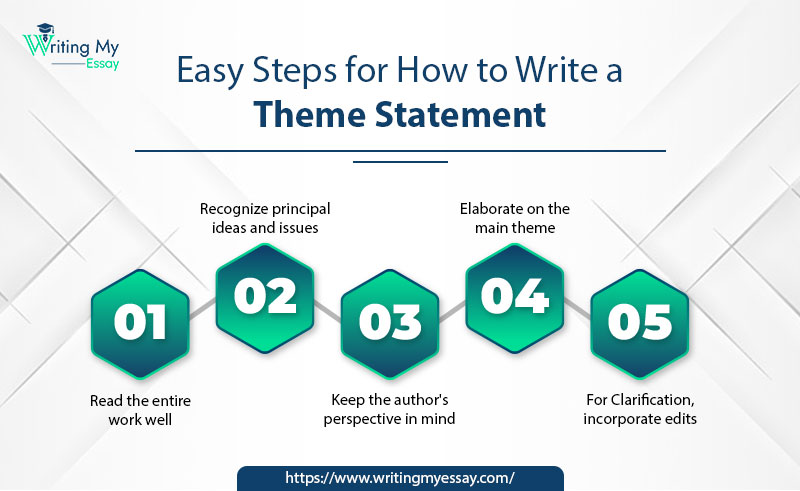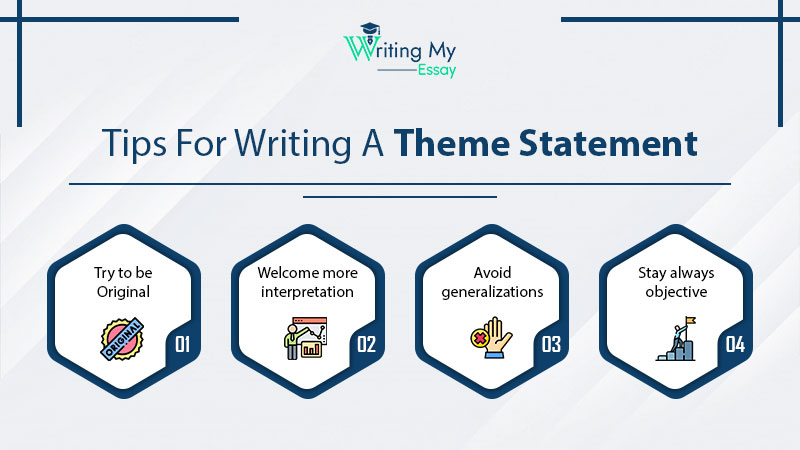In creative writing, knowing how to write a theme statement is itself a big task. As the theme of a story is the significant factor the writer aims to make through their work of fiction. A piece of literature will probably discover many unique themes, but, one in particular. Themes aren’t always morals. Rather than immediately prescribe a course of action to the reader. A theme is so an insightful observation about the human condition and the world at large.
Contents
What Is a Theme Statement?
This section will answer what is a theme. A subject assertion is a quick description of the thematic concept of a piece of writing. The theme statements can also additionally describe the thematic ideas of novels, quick stories, essays, articles, or any other type of literature that has a main message or idea. Themes in writing are the thoughts the writer needs to express. It will consist of thoughts about life, human nature, culture, or society.
Professionals who work in literature or publishing can also additionally need to broaden their understanding and ability how to write a theme statement. So they can meet their everyday tasks. As an expert writer or publisher, the theme statements are an important way to deliver the purpose and main message of your writing or the works you publish.
Understanding how to write a theme statement may additionally assist students or lecturers when creating thesis statements.
Easy Steps for How to Write a Theme Statement
Learning how to write a theme statement isn’t tough in case you follow some easy steps. First of all, a theme statement or thematic statement describes a significant idea inside a piece of literature. It’s the point the author is attempting to make during the work.
This is going further than simply the theme topic of love, for example, to make clear the exact statement about love a writer was making. There are some easy steps you can follow to jot down a powerful subject assertion. Consider the following recommendation that will help you comprehensively how to write a theme statement:

1. Read the entire work well
Before writing your theme statement, it is vital that you examine and completely understand the material. While studying the material, keep in mind noting and recording the characters, plot, writing style, and perspectives. This data can also additionally assist you to decide the main message of the writing. It will make a contribution to a successful interpretation of the writer’s supposed theme.
2. Recognize principal ideas and issues
After very well studying the material, you can pick out any conflicts or significant ideas that recurred during the content. Do your excellent to remember any values, motives, or pursuits that often seemed during the text. This data is vital to understanding how to write a theme statement and the main message the writer is supposed to deliver and will assist you to prepare your mind before writing a theme statement.
To understand a writer’s motivation for writing a piece of literature, you can need to do a little research to gain insight into their perspective. Try to broaden an understanding of their background, lifestyle experiences, ideals, and motivations. This can also additionally help you form a better understanding of the intentions behind the text and the message they are looking to send via their writing about lifestyles, human behavior, and society.
4. Elaborate on the main theme
Now that you’ve shaped an interpretation of the significant theme, you understand how to write a theme statement too. The theme statements are generally one to 2 sentences in length, so do your best to deliver all the vital information about the primary message as concisely as possible. You may additionally include evidence through events in the story to back up your claims about the theme. You can also additionally consider following a theme statement template just like the one below to help in your efforts to write my essay statement:
In [name of the piece of writing], the writer gives the concept that [central message]. When [event from the story that confirms your interpretation] happens, it outcomes in [the result of the event], which demonstrates the [element of the central message].
5. For clarification, incorporate edits
Before finalizing your theme statement, do a high-quality edit of your work for clarity on how to write a theme statement. Consider any times of repetition, complicated wording or phrasing, or areas wherein you may more clearly express your thoughts. This can also additionally help your theme statement to consciously express the main message of the text and will make a contribution to its performance and effectiveness.
Tips For Writing A Theme Statement
For writing and publishing professionals, the theme statements offer a clear and complete knowledge of a writer’s primary message. There are many times wherein expert writers, publishers, or lecturers can also additionally need to create a powerful theme statement. Understanding the components of how to write a theme statement can also additionally make contributions to your success in this area. In this article, we outline theme statements and provide a listing of more suggestions that will help you write an impactful theme statement.
Below are a few more suggestions that will help you write a successful theme statement:

1. Try to be Original
When understanding how to write a theme statement, it is vital to stay unique in your thoughts even as conveying the thoughts of the writer. To continue to be unique, do your best to avoid cliches or overly used expressions. Do your excellent to express the writer’s precise angle on thoughts, although the thoughts are common in society or amongst works of literature. You may additionally beautify the originality of your theme statement by combining your personal interpretation of the textual content with the recognized beliefs and ideals of the writer.
2. Welcome more interpretation
While authors frequently have a selected idea or thought they want to deliver through their work, it is able to be beneficial for readers to create their personal interpretations of the subject. To permit an interpretation of your theme statement, do your excellent to keep away from any absolute statements. You can also additionally try this by softening your language and changing any phrases like, “always,” “is” and “must” with phrases that permit more flexibility, such as “may,” “could” or “frequently.”
3. Avoid generalizations
Generalizations can also additionally save your readers from forming their very own reviews about the primary message and will have an effect on the effectiveness of your theme statement. Whenever possible, try and eliminate generalizations or assumptive statements from your evaluation to make sure that your reader’s experience they are able to shape their personal interpretations of the primary message.
4. Stay always objective
It’s vital that your theme statement would not act as a piece of recommendation or command to your readers. Do your best to stay objective and state the primary message in a manner that does not prompt a call to action. Try to portray the writer’s angle in a straightforward, matter-of-fact way without suggesting how your readers need to reply to their ideas or have an effect on the primary message together with your personal reviews.
Things to Avoid When Creating Theme Statements
While making thematic statements is quite straightforward, it could be easy to get too familiar or cliché. So, whilst developing a theme statement, it’s vital to remember:
- Don’t point out specific books, names, or occasions.
- For example, love makes the heart grow fonder. So, Avoid clichés.
- Do now no longer summarize the work.
- Avoid absolute terms (for example, always, none).
- Don’t overgeneralize (for example, love is love).
Good and Bad Theme Statement Examples
Now that you realize how to write a theme statement, it’s time to look at a few good and bad thematic statement examples.
- Good: Bravery allows humans to push forward towards adversity even if they fail to make a change.
- Bad: The theme of this novel is courage and bravery.
- Good: Friends are those who will guide you even if the entire world is after you.
- Bad: Friends make the world go round.
- Good: Poverty can push you to do sudden things that go against your very own morals.
- Bad: Poverty causes people to commit crimes.
Bottom Line
The theme statements can appear intimidating when you ask yourself how to write theme statement. But while you break down the individual pieces of the theme statement, they aren’t so tough to create. Learn more about writing my essay and topics by finding out the theme examples. All this theme information combined assists you to teach the theme or study it on your very own.
Related Post:
